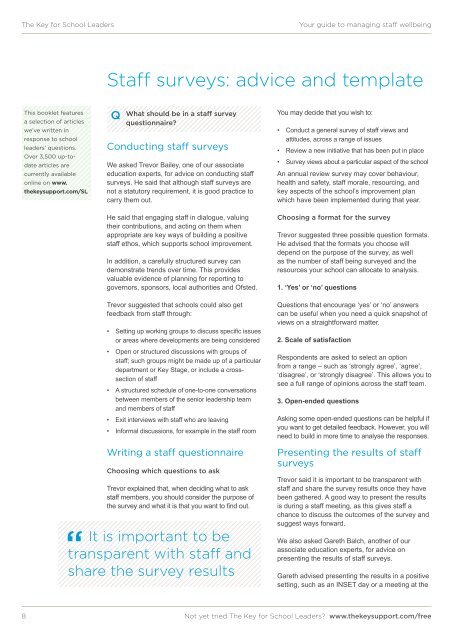Your guide to managing staff wellbeing
25ybGf5
25ybGf5
Create successful ePaper yourself
Turn your PDF publications into a flip-book with our unique Google optimized e-Paper software.
The Key for School Leaders<br />
<strong>Your</strong> <strong>guide</strong> <strong>to</strong> <strong>managing</strong> <strong>staff</strong> <strong>wellbeing</strong><br />
Staff surveys: advice and template<br />
This booklet features<br />
a selection of articles<br />
we’ve written in<br />
response <strong>to</strong> school<br />
leaders’ questions.<br />
Over 3,500 up-<strong>to</strong>date<br />
articles are<br />
currently available<br />
online on www.<br />
thekeysupport.com/SL<br />
What should be in a <strong>staff</strong> survey<br />
questionnaire?<br />
Conducting <strong>staff</strong> surveys<br />
We asked Trevor Bailey, one of our associate<br />
education experts, for advice on conducting <strong>staff</strong><br />
surveys. He said that although <strong>staff</strong> surveys are<br />
not a statu<strong>to</strong>ry requirement, it is good practice <strong>to</strong><br />
carry them out.<br />
He said that engaging <strong>staff</strong> in dialogue, valuing<br />
their contributions, and acting on them when<br />
appropriate are key ways of building a positive<br />
<strong>staff</strong> ethos, which supports school improvement.<br />
In addition, a carefully structured survey can<br />
demonstrate trends over time. This provides<br />
valuable evidence of planning for reporting <strong>to</strong><br />
governors, sponsors, local authorities and Ofsted.<br />
Trevor suggested that schools could also get<br />
feedback from <strong>staff</strong> through:<br />
• Setting up working groups <strong>to</strong> discuss specific issues<br />
or areas where developments are being considered<br />
• Open or structured discussions with groups of<br />
<strong>staff</strong>; such groups might be made up of a particular<br />
department or Key Stage, or include a crosssection<br />
of <strong>staff</strong><br />
• A structured schedule of one-<strong>to</strong>-one conversations<br />
between members of the senior leadership team<br />
and members of <strong>staff</strong><br />
• Exit interviews with <strong>staff</strong> who are leaving<br />
• Informal discussions, for example in the <strong>staff</strong> room<br />
You may decide that you wish <strong>to</strong>:<br />
• Conduct a general survey of <strong>staff</strong> views and<br />
attitudes, across a range of issues<br />
• Review a new initiative that has been put in place<br />
• Survey views about a particular aspect of the school<br />
An annual review survey may cover behaviour,<br />
health and safety, <strong>staff</strong> morale, resourcing, and<br />
key aspects of the school’s improvement plan<br />
which have been implemented during that year.<br />
Choosing a format for the survey<br />
Trevor suggested three possible question formats.<br />
He advised that the formats you choose will<br />
depend on the purpose of the survey, as well<br />
as the number of <strong>staff</strong> being surveyed and the<br />
resources your school can allocate <strong>to</strong> analysis.<br />
1. ‘Yes’ or ‘no’ questions<br />
Questions that encourage ‘yes’ or ‘no’ answers<br />
can be useful when you need a quick snapshot of<br />
views on a straightforward matter.<br />
2. Scale of satisfaction<br />
Respondents are asked <strong>to</strong> select an option<br />
from a range – such as ‘strongly agree’, ‘agree’,<br />
‘disagree’, or ‘strongly disagree’. This allows you <strong>to</strong><br />
see a full range of opinions across the <strong>staff</strong> team.<br />
3. Open-ended questions<br />
Asking some open-ended questions can be helpful if<br />
you want <strong>to</strong> get detailed feedback. However, you will<br />
need <strong>to</strong> build in more time <strong>to</strong> analyse the responses.<br />
Writing a <strong>staff</strong> questionnaire<br />
Choosing which questions <strong>to</strong> ask<br />
Trevor explained that, when deciding what <strong>to</strong> ask<br />
<strong>staff</strong> members, you should consider the purpose of<br />
the survey and what it is that you want <strong>to</strong> find out.<br />
It is important <strong>to</strong> be<br />
transparent with <strong>staff</strong> and<br />
share the survey results<br />
Presenting the results of <strong>staff</strong><br />
surveys<br />
Trevor said it is important <strong>to</strong> be transparent with<br />
<strong>staff</strong> and share the survey results once they have<br />
been gathered. A good way <strong>to</strong> present the results<br />
is during a <strong>staff</strong> meeting, as this gives <strong>staff</strong> a<br />
chance <strong>to</strong> discuss the outcomes of the survey and<br />
suggest ways forward.<br />
We also asked Gareth Balch, another of our<br />
associate education experts, for advice on<br />
presenting the results of <strong>staff</strong> surveys.<br />
Gareth advised presenting the results in a positive<br />
setting, such as an INSET day or a meeting at the<br />
8 Not yet tried The Key for School Leaders? www.thekeysupport.com/free


